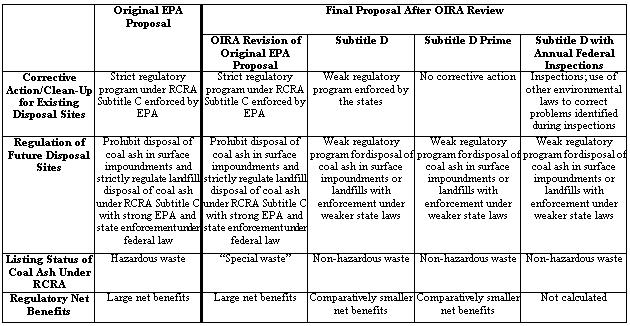
Eye on OIRA: Government Releases Before-and-After Docs on Coal Ash Rule; Lisa Jackson, Public Face of Environmental Protection, Meet Nameless White House Economist
by Rena SteinzorThis post is written by CPR President Rena Steinzor and CPR Policy Analyst James Goodwin.
President Obama appointed Lisa Jackson to head the Environmental Protection Agency (EPA) on December 15, 2008. Confirmed by the Senate on January 22, 2009, she is a Cabinet-rank member of the Administration and the first African American to serve as the public face of environmental protection for any administration. Whether she wears an EPA baseball cap and windbreaker to tour the waterfront of her native New Orleans, now threatened by the BP oil spill, or she sits in the witness chair with television lights in her face to testify before any one of the dozen congressional committees claiming a piece of her agency, Jackson rises or falls on her own merits. And she has mostly been rising, driving her 18,000 member staff to new levels of activity and invention.
How lamentable, then, that her first notable reversal was administered not by Mother Nature, Congress, the economy, or even her own mistakes, but rather by an unnamed squad of number-crunching economists working in the bowels of Peter Orszag’s Office of Management and Budget (OMB), and specifically within the Office of Information and Regulatory Affairs (OIRA), headed by Cass Sunstein. And what a nasty reversal it was. Taking a page out of the George W. Bush Administration’s playbook, the economists decided to second-guess Jackson’s judgment on how to deal with 1,000 or so leaking, unstable coal ash dump sites threatening communities across the country. A few days after announcing its proposal to the public, EPA at last gave us a peak behind the curtain of obscurity OIRA had erected around months of intensive industry lobbying, posting a red-lined version of the toxic coal ash regulatory proposal it sent over to the economists last October.
OMB revisions to the EPA proposal include about 140 pages of deletions and style edits, but also dozens, perhaps more than a hundred, added pages (the key differences in the proposals are summarized in the table below). As originally drafted by EPA, the regulation required that the 140 million tons of coal ash generated by power plants each year, which are laden with extraordinarily toxic heavy metals such as beryllium, lead, and chromium, either be disposed of in “dry” landfills lined and monitored to keep the ash out of soil and water, or beneficially recycled, such as in concrete road beds. Existing dump sites would be closed in accordance with additional regulatory requirements, ensuring that they would not burst open, as one such pit did in Kingston, Tennessee, shortly before Christmas 2008, spilling 1 billion gallons of inky black sludge across 400 acres of this small rural community.
But by the time the OMB economists had chewed over the proposal, EPA was no longer presenting a clear and unambiguous policy to the public for comment. Instead, EPA had been reduced to proposing three inconsistent alternatives: (1) a somewhat weakened version of its own strict approach; (2) a weak alternative that would subject coal ash sites to the same requirements that apply to ordinary household garbage, mandate limited cleanup, and hope that the states have the will to take care of a problem they have neglected for decades; (3) an unthinkably toothless alternative that would neglect cleanup of existing sites entirely. (The agency is also soliciting comment on a fourth alternative, a variation on the weak alternative that would involve annual inspections of existing sites.) When you consider that 186 of 584 coal ash “surface impoundments” (the euphemism for a waterlogged pit-in-ground) were not even designed by professional engineers, the consequences of OIRA’s misguided intervention, should one of these weak alternatives succeed, is almost laughable.
Born in the Reagan Age of Deregulation, Sunstein’s office exists to conduct “White House review” of agency actions to ensure that all the President’s men and women are on the same page. Obama’s people, including Solicitor General Elena Kagan, now on the short list for the Supreme Court, have extolled White House review under Democrats as a far more positive, even golden opportunity for agencies to have the President adopt their affirmative agendas, much as President Bill Clinton worked side-by-side with then-Food and Drug Administration Commissioner David Kessler to curb smoking among youth.
Whether by accident or design, the Sunstein operation is far closer to the Reagan than the Kagan model. In fact, we cannot think of a single incident under the Reagan or the Bush presidencies where OMB actually had the temerity to pick up a laptop and actually add what amounts to chapters of changes to a rule, converting it from a single proposal to a mushy collection of three, increasingly industry-friendly alternatives. Return letters were sent to agencies chiding them and asking for a “do-over” of their work. But chunks of cheaper, more industry-friendly alternatives were not slapped as side cars onto the agencies' original expert judgment.
So obscure was this process that it is reasonable to wonder whether Peter Orszag, Jackson’s peer in every way, even knows that economists several levels down his organizational chart have second-guessed her judgment. Or has Jackson been such a good team player that the confrontation remained focused at the level of former Harvard Professor Sunstein, who seems only too ready to turn his surrogates loose to correct EPA’s work?
In either event, this ain’t your grandfather’s White House review, nor is it a process to make any President proud. Expertise is tossed aside, industry is given irresistible incentives to end-run agency rules, and accountability in the constitutional sense, through executive appointments, Senate confirmation, and the public spotlight, is perilously undermined.

(See full-size PDF of chart).
© 2014 The Center for Progressive Reform